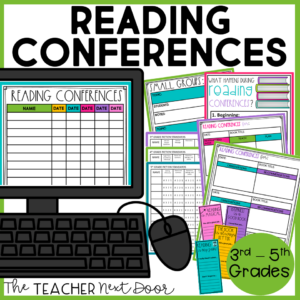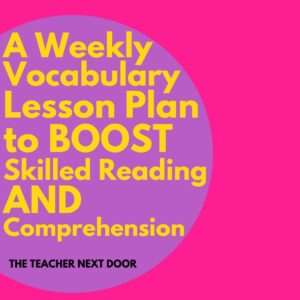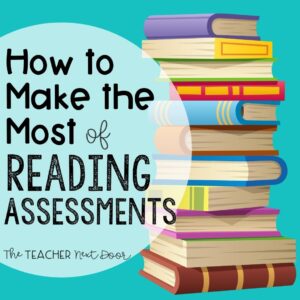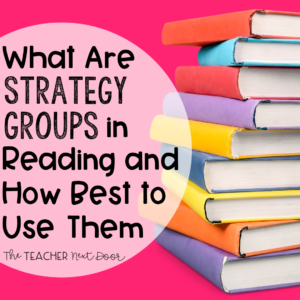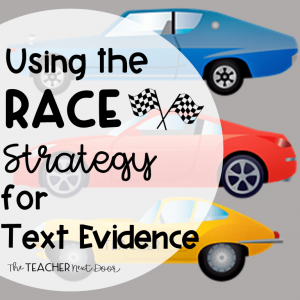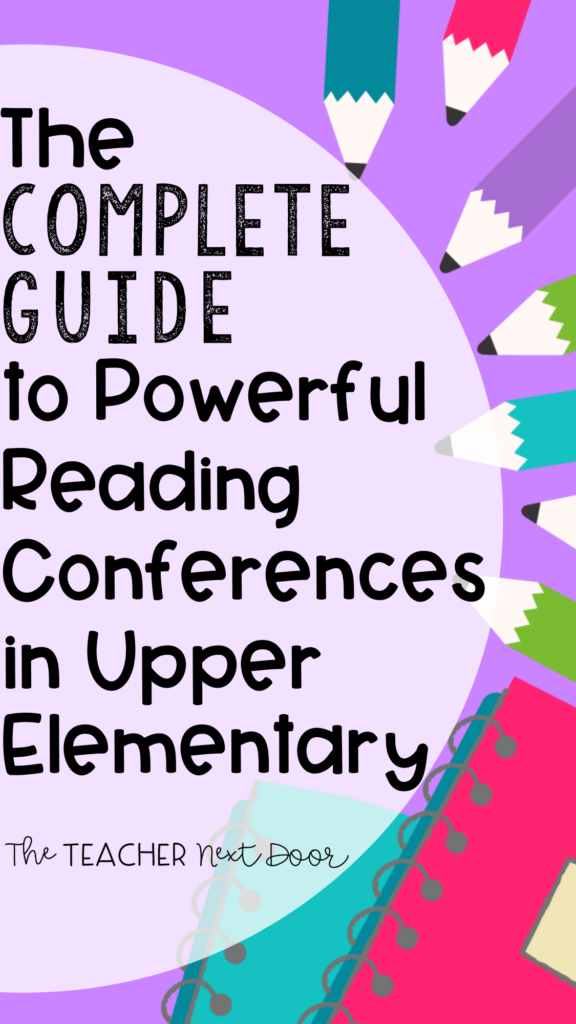
Reading Conferences are an excellent way to build literary-based relationships with your students.
No matter where students are on their learning journey, you can meet them there and guide them along during these meaningful sessions that only last a few minutes.
If you think back to when you were in school, how much one-on-one time did you get with your teachers? I bet your answer is similar to mine, almost none.
Usually, the only time adults remember being one-on-one with a teacher was if they were in trouble! Yikes!
Reading conferences flip the script on this stereotype entirely.
For a few moments, each student is at the center. The learning at hand is the sole focus. This is powerful!
Now, imagine routinely meeting with students to discuss where they’re at on their literary journey. Wow! What an impact this individualized instruction can have on a young reader!
To get you started, here’s the complete guide to POWERFUL reading conferences in upper elementary!
Setting Up Reading Conferences
We’re starting at the very beginning! Let’s plan how we want our reading conference time to look, feel, and operate before we take any action.
The more you have ironed out before starting, the smoother your reading conferences will run.

Prepping Our Reading Conference Materials
Here’s a comprehensive (and yet highly flexible) list of materials that you’ll find helpful for running reading conferences in your classroom:
- Modeling Reading Conferences & Setting Expectations Anchor Charts
- Quick Feedback Bookmarks
- Conference Date Tracker
- Conference Schedule
- Student Feedback Forms
- Reading Conference Guiding Questions
- Student Behaviors Observation Form(s)
- Student Self-Reflection Forms
- Reading Standards List
- Post-Conference Record-Keeping Pages
That may seem like a long list, but once I prep all these materials, they live in my Reading Conferences Binder that I keep on my small group rolling cart all year long. Getting prepped ahead of time is so worth it.
It’s also great to be able to grab my binder and go so that no precious conference time is wasted.
The minutes matter during Reading Conference time! The more efficient you can make this system, the better!

Teacher Storage & Student Storage
As mentioned, I use a binder to store my copies used for reading conferences. In addition, I use page protectors to store multiple copies of items that I use often (feedback forms, student reflection forms, etc.). Of course, you could also use a digital version if that’s your preference.
To make copying easier, I use a yellow highlighter and write “MASTER COPY” across one copy placed in my binder. This way, I’m not reprinting a copy each time I need one. My copier does not pick up the yellow highlighter, just the black ink! (Fair warning, I’ve heard that some newer copiers do pick up the yellow highlighter, so test this first before hitting copy on a set of 30 papers!)
One of the first mini-lessons we do at the beginning of the year is about how to set up Reader’s Notebooks. I like to have students create these using composition books, although we’ve also used binders and spiral-bound notebooks in the past!
Of course, there are pluses and minuses for each of these storage options. While you do need all students to use the same kind of notebooks, you’ll definitely want to pick a method that works best for you!
Besides lots of other reading materials, my students store their ongoing reading conference items within their Reader’s Notebooks as reminders of what we discussed.
Why You’ll Never Regret Modeling Reading Conferences with Students
If your students have never participated in reading conferences before, there is no practice that I could recommend more than modeling.
Before you begin conferencing, you must set the stage for what you want conferences to look, feel, and sound like.
This means setting expectations for what is happening during conferences and, more importantly, setting expectations for what other students are doing while you conference.
Some years, I can fly through modeling and setting expectations because I have a group of kids who jive well together.
Other years, I’ve modeled and modeled, and reminded, and modeled once again. This is entirely dependent on your students and their needs each year.
Fear not; I have good news! Even with my most challenging classes, I have been able to successfully commit to reading conferences! It just takes a bit more rigid structure, and sometimes that’s okay!
Let’s talk about what happens before the first Reading Conference even takes place. This is when I set the stage for what students can expect during Reading Conferences.
Here are the questions that I go over:
- What’s a Reading Conference?
- What happens during Reading Conferences?
- How do Reading Conferences help readers?
- How do I prepare for a Reading Conference?
For each of these questions, I give students a handout that goes directly into the first few pages of their Reader’s Notebooks. This way, if I need to review expectations with everyone (or just one student) later, we pull out our Reader’s Notebooks and take a peek.
I want to emphasize the importance of the third question, “How do Reading Conferences help readers?”
This is the most important piece of Reading Conferences training. This is where I build buy-in from my students. Without this piece, Reading Conferences lack meaning, and that’s when behavior starts to go off the rails.
I cannot emphasize how important it is for students to understand why this time is so meaningful.
Sharing the meaning behind reading conferences helps students regulate their actions and behaviors during their own Reading Conferences and also helps them understand why it is so important to be respectful during other students’ Reading Conferences.
After our notebooks are prepped, it’s time to model. You can do this one of two ways.
If you’re lucky enough to have an awesome paraprofessional in your classroom, you can use him/her to help you model what reading conferences should look, sound, and feel like. If not, it’s also great to simply grab a student and model a Conference to the entire class.
While modeling, be sure that both you and the “student” in the mock Reading Conference have all of the materials that will be used once real Conferences begin.
What to Model During a Mock Conference:
Begin by welcoming the “student” and checking in with him/her as a reader. You might ask something like, “What are you working on as a reader right now” or “When we chatted about your reading last time, you told me that you were going to try _____. How’s that going?”
You want students to understand the idea that conferences are held to help them grow as a reader. Emphasize that the student’s role at a conference is to participate by sharing about the book he/she is reading and what they’ve been thinking about as a reader.
Present conferences as a low-stakes environment meant to help the student. No grades will be taken and nothing about this time should be punitive. The purpose is to help students learn reading strategies to help them as readers.
Explain that the student will read aloud to the teacher. Discuss how that should look and sound. This is a great time to set expectations for what students who are not conferencing will be doing and how that looks and sounds.
I choose to conference with students during independent reading time, meaning that it’s really quiet in my classroom during this time (if all is going well).
Again, this has been incredibly easy to maintain during some school years, and it has taken a lot of practice in other years. You CAN do this, though.
Before you start reading conferences, I do recommend giving ample time (several weeks) for students to learn more about Reader’s Workshop routines and especially to establish a strong independent reading time first. This will help students who need to build up their reading stamina! Plus, you’ll want them to dive right into their books! Once the stage is set and students understand their role in Reading Conferences and during independent reading, it’s time to give it a try!
Scheduling and Executing Reading Conferences
I highly recommend making a schedule of when you’re meeting with each student. For example, if you know students will be independently reading for 20 – 30 minutes each day, plan to have 3-4 conferences each day.
Use a calendar to map out who you will be meeting with and when. Check off names and jot down dates as you hold a Reading Conference with each student.
Creating a checklist helps keep yourself accountable when students are absent.
Timing
You’ll want to make sure that your reading conferences are kept fairly short at 5 to 7 minutes. That time can really fly by if you’re not careful.
Remember, you’ll want to focus on only ONE of the most important or helpful reading concepts that the student needs to learn. Sometimes the student’s needs may be similar to the mini-lesson concept you’ve been working on as a class, but many times it’s entirely based on what the specific student needs at that time.

Format
While each reading conference will be focused on each student as a reader, making each conference unique, there’s still a basic format that I use for every conference, with few exceptions.
- Reader Check-in – Greet the student and ask a general question about how their reading is going or what he/she has been thinking lately as reader. (1 minute)
- Take a look at his/her Reader’s Notebook briefly to gain insight into the student’s thoughts as a reader. (1-2 minutes)
- Listen to the student read aloud – usually right where they left off or you can have students mark a place in advance that they’d love to read to you with a bookmark or sticky note. (1 minute)
- Compliment the student about what you noticed while he/she was reading. What is he/she doing well? (1 minute)
- Teach/coach the student, focusing on ONE thing to push him/her as a reader. (2 minutes)
- Reinforce the reading strategy mentioned and have the student verbalize what he/she will do to practice this strategy/skill before the next conference. Close the conference. (1 minute)
Questions
Whether you know exactly what you plan to work on with a student during the conference, or if you discover something that the student needs to master after listening to him/her read during the conference, it’s extremely helpful to have a set of guiding questions ready to go! These will help keep your conferences targeted, efficient, and aligned to grade-level standards.
Be sure to choose questions that work for a wide variety of books, that are open-ended enough to allow the students to share their thinking as readers, and that your questions also target higher level thinking too. One thing I love about using a set of guiding questions is that they help reduce the fear of having to think of meaningful questions on the fly! Having a simple list of good questions can reassure new and veteran teachers when teacher-brain tiredness sometimes creeps in.
One of the BIGGEST Questions about Reading Conferences
If you’re new to Reading Conferences, you might be asking yourself how you’ll be able to run them without reading every single book in your classroom and school library first.
I have two quick thoughts I want to share here:
- After running Reading Conferences for a while, you’ll become a PRO at knowing about so many books that this won’t be a problem whatsoever.
- Even if a student is reading something that you have not read, you’ll be able to confidently gauge their understanding just by the quality of their answers to your questions. If a student isn’t comprehending what they’re reading or struggling to answer a grade-level question, you’ll know! I promise!
Keeping a Paper Trail of Reading Conferences and Why It’s Important
At this point, you’ve already kept track of who you’re meeting with and when. The last step to maintaining a paper trail is to keep data on what each student is doing well and what he/she needs to work on. (I promise you’ll forget if you don’t keep track. Speaking from experience…)
Two Ways to Keep a Paper Trail:
1) I’ve kept track of Reading Conference Data on paper and kept that paper in a binder. This binder came with me to parent-teacher conferences and what we call “problem-solving meetings.” Problem-solving meetings are also known as intervention meetings between you, the reading specialist, and other stakeholders within the school.
2) I’ve kept track of what I’ve worked on with each student electronically.
It takes about 30 seconds for me to jot down what each student did well and what they need to work towards.
This information is SO valuable. It helps provide a reference for what the student is learning as a reader and how he/she is growing. Do not skip this step!
Plus, it covers your behind if you’re asked to provide documentation on a student’s progress.

Encouraging Student Self-Reflection
I am all about metacognition or the process of thinking about your thinking.
When I wrap up a conference, I want it to stick with students. After providing them with a feedback bookmark, I sometimes give them a self-reflection form to add to their Reader’s Notebook and a few other “data tracking” components seen below.
I ask students to think about their strengths and areas of opportunity after meeting with me. Sometimes, this private time to reflect is more meaningful than the conference itself.
Remember, conferences for students are a low-stakes environment, meaning that students are more comfortable reflecting when nothing is riding on it. Keeping it positive with a “reader to reader” tone makes it more of an enjoyable learning experience for your students.

I’ve Read the Complete Guide to POWERFUL Reading Conferences, now what?
After reading through this step-by-step guide, you’re ready to take these steps into action!
At this point, you can create your own Reading Conference process and materials.
If you’re in the market to save oodles of time prepping for Reading Conferences, you can grab all of the resources featured in this post and MANY more in my Reading Conferences Unit!
CLICK HERE to take a look at the Reading Conferences unit.
Now that you have a handle on how to run reading conferences, maybe you’re wondering about how to plan for Reading Workshop?
If you’d like to plan out the grade level reading skills and mini-lessons your students need for the year, I have a FREE set of pacing guides for 3rd, 4th, and 5th grades that I’d love to share with you.
The pacing guides are organized by weeks and come in color, black and white, and in editable formats too, so you can tweak them to match your needs.
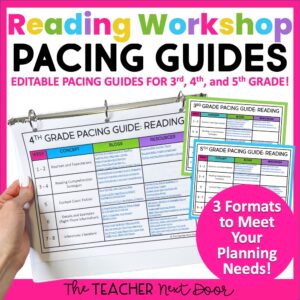
IF YOU LIKED THIS BLOG, YOU MAY ALSO BE INTERESTED IN:
-
Everything You Need to Know About Launching Reading Workshop
-
Making the Most of Reading Workshop’s Independent Reading Time


